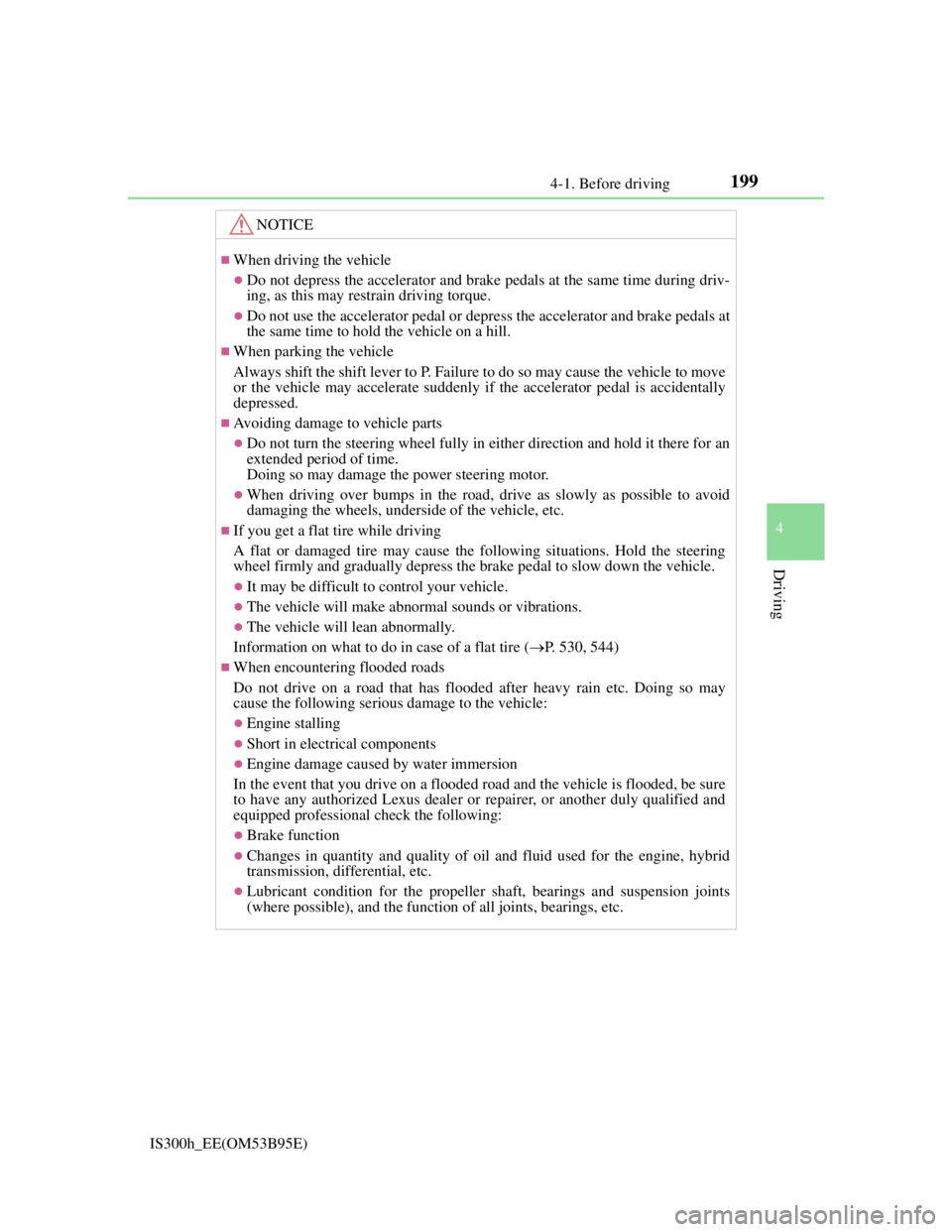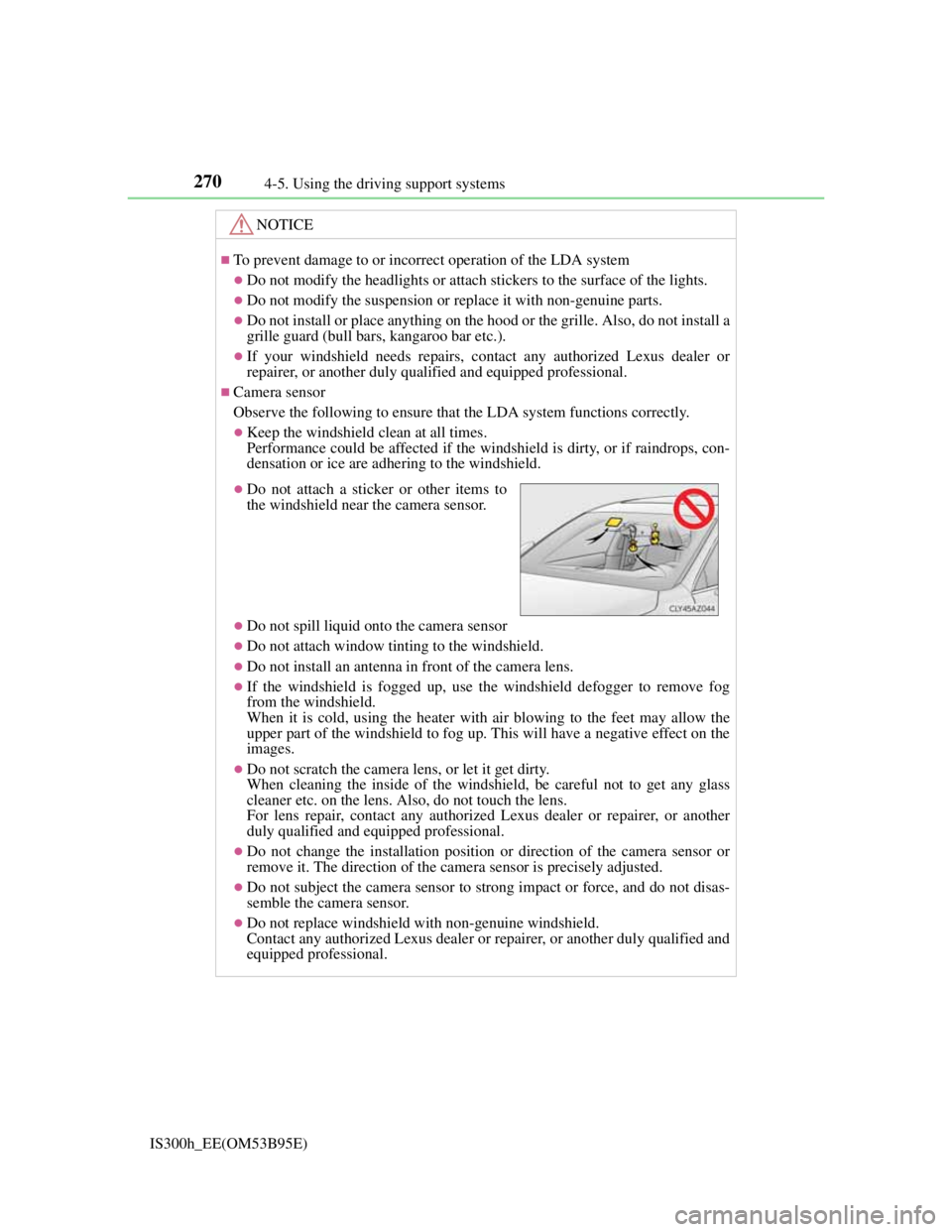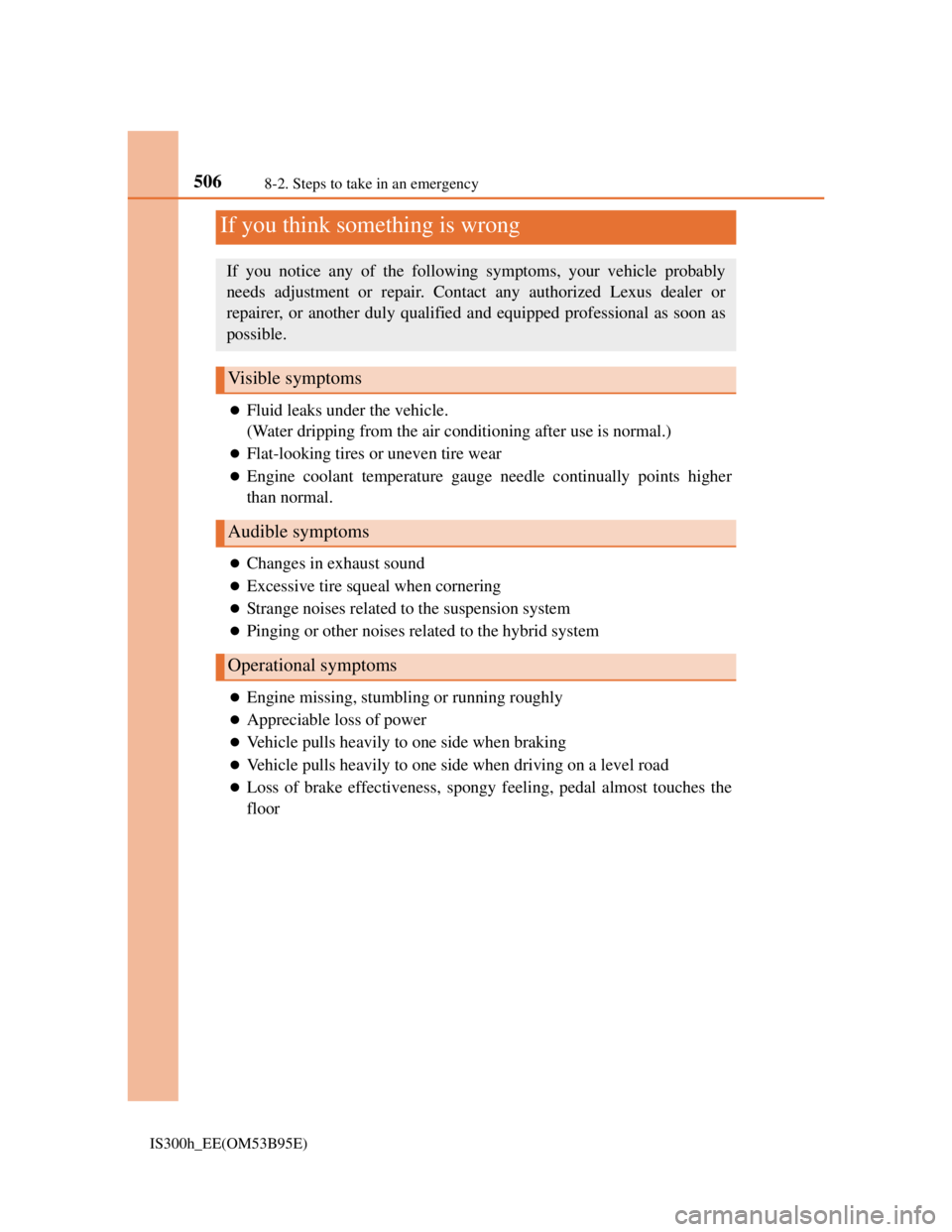air suspension Lexus IS300h 2013 Owner's Manual
[x] Cancel search | Manufacturer: LEXUS, Model Year: 2013, Model line: IS300h, Model: Lexus IS300h 2013Pages: 628, PDF Size: 20.23 MB
Page 48 of 628

481-1. For safe use
IS300h_EE(OM53B95E)
CAUTION
SRS airbag precautions
Do not strike or apply significant levels of force to the area of the SRS airbag
components.
Doing so can cause the SRS airbags to malfunction.
Do not touch any of the component parts immediately after the SRS airbags
have deployed (inflated) as they may be hot.
If breathing becomes difficult after the SRS airbags have deployed, open a
door or window to allow fresh air in, or leave the vehicle if it is safe to do so.
Wash off any residue as soon as possible to prevent skin irritation.
If the areas where the SRS airbags are stored, such as the steering wheel pad
and front and rear pillar garnishes are damaged or cracked, have them
replaced by any authorized Lexus dealer or repairer, or another duly qualified
and equipped professional.
Modification and disposal of SRS airbag system components
Do not dispose of your vehicle or perform any of the following modifications
without consulting any authorized Lexus dealer or repairer, or another duly
qualified and equipped professional. The SRS airbags may malfunction or
deploy (inflate) accidentally, causing death or serious injury.
Installation, removal, disassembly and repair of the SRS airbags
Repairs, modifications, removal or replacement of the steering wheel, instru-
ment panel, dashboard, seats or seat upholstery, front, side and rear pillars or
roof side rails
Repairs or modifications of the front fender, front bumper, or side of the occu-
pant compartment
Installation of snow plows, winches, etc. to the front grille (bull bars or kan-
garoo bar etc.)
Modifications to the vehicle’s suspension system
Installation of electronic devices such as mobile two-way radios, RF-trans-
mitters and CD players
Modifications to your vehicle for a person with a physical disability
Page 59 of 628

591-1. For safe use
1
For safety and security
IS300h_EE(OM53B95E)
NOTICE
Pop Up Hood precautions
Make sure to close the hood before driving, as the system may not operate
properly if the hood is not fully closed.
Make sure that all 4 tires are of the specified size and inflated to the specified
tire pressure (P. 570). If tires of a different size are used, the system may
not operate properly.
If something has hit the area around the front bumper, the sensors may be
damaged even if the Pop Up Hood has not operated. Have the vehicle
inspected by any authorized Lexus dealer or repairer, or another duly quali-
fied and equipped professional.
Do not remove or repair the parts or wiring of the Pop Up Hood, as doing so
may cause accidental operation or prevent the system from operating prop-
erly. If repair or replacement is necessary, contact any authorized Lexus
dealer or repairer, or another duly qualified and equipped professional.
Do not remove such components as the front bumper, hood or suspension, or
replace them with non-genuine parts, as doing so may prevent the system
from operating properly.
Do not install anything to the front bumper or hood, as doing so may prevent
the sensors from detecting an impact correctly and prevent the system from
operating properly.
Do not close the hood with force or apply load to the lifters, as doing so may
damage the lifters and prevent the system from operating properly.
Do not modify the suspension, as changes made to the vehicle height may
prevent the system from operating properly.
Page 201 of 628

1994-1. Before driving
4
Driving
IS300h_EE(OM53B95E)
NOTICE
When driving the vehicle
Do not depress the accelerator and brake pedals at the same time during driv-
ing, as this may restrain driving torque.
Do not use the accelerator pedal or depress the accelerator and brake pedals at
the same time to hold the vehicle on a hill.
When parking the vehicle
Always shift the shift lever to P. Failure to do so may cause the vehicle to move
or the vehicle may accelerate suddenly if the accelerator pedal is accidentally
depressed.
Avoiding damage to vehicle parts
Do not turn the steering wheel fully in either direction and hold it there for an
extended period of time.
Doing so may damage the power steering motor.
When driving over bumps in the road, drive as slowly as possible to avoid
damaging the wheels, underside of the vehicle, etc.
If you get a flat tire while driving
A flat or damaged tire may cause the following situations. Hold the steering
wheel firmly and gradually depress the brake pedal to slow down the vehicle.
It may be difficult to control your vehicle.
The vehicle will make abnormal sounds or vibrations.
The vehicle will lean abnormally.
Information on what to do in case of a flat tire (P. 530, 544)
When encountering flooded roads
Do not drive on a road that has flooded after heavy rain etc. Doing so may
cause the following serious damage to the vehicle:
Engine stalling
Short in electrical components
Engine damage caused by water immersion
In the event that you drive on a flooded road and the vehicle is flooded, be sure
to have any authorized Lexus dealer or repairer, or another duly qualified and
equipped professional check the following:
Brake function
Changes in quantity and quality of oil and fluid used for the engine, hybrid
transmission, differential, etc.
Lubricant condition for the propeller shaft, bearings and suspension joints
(where possible), and the function of all joints, bearings, etc.
Page 272 of 628

2704-5. Using the driving support systems
IS300h_EE(OM53B95E)
NOTICE
To prevent damage to or incorrect operation of the LDA system
Do not modify the headlights or attach stickers to the surface of the lights.
Do not modify the suspension or replace it with non-genuine parts.
Do not install or place anything on the hood or the grille. Also, do not install a
grille guard (bull bars, kangaroo bar etc.).
If your windshield needs repairs, contact any authorized Lexus dealer or
repairer, or another duly qualified and equipped professional.
Camera sensor
Observe the following to ensure that the LDA system functions correctly.
Keep the windshield clean at all times.
Performance could be affected if the windshield is dirty, or if raindrops, con-
densation or ice are adhering to the windshield.
Do not spill liquid onto the camera sensor
Do not attach window tinting to the windshield.
Do not install an antenna in front of the camera lens.
If the windshield is fogged up, use the windshield defogger to remove fog
from the windshield.
When it is cold, using the heater with air blowing to the feet may allow the
upper part of the windshield to fog up. This will have a negative effect on the
images.
Do not scratch the camera lens, or let it get dirty.
When cleaning the inside of the windshield, be careful not to get any glass
cleaner etc. on the lens. Also, do not touch the lens.
For lens repair, contact any authorized Lexus dealer or repairer, or another
duly qualified and equipped professional.
Do not change the installation position or direction of the camera sensor or
remove it. The direction of the camera sensor is precisely adjusted.
Do not subject the camera sensor to strong impact or force, and do not disas-
semble the camera sensor.
Do not replace windshield with non-genuine windshield.
Contact any authorized Lexus dealer or repairer, or another duly qualified and
equipped professional.
Do not attach a sticker or other items to
the windshield near the camera sensor.
Page 278 of 628

2764-5. Using the driving support systems
IS300h_EE(OM53B95E)
Sensor detection information
The sensor’s detection areas are limited to the areas around the vehicle’s front
corner and rear bumpers.
Certain vehicle conditions and the surrounding environment may affect the
ability of the sensor to correctly detect obstacles. Particular instances where this
may occur are listed below.
• There is dirt, snow or ice on the sensor. (Wiping the sensors will resolve this
problem.)
• The sensor is frozen. (Thawing the area will resolve this problem.)
In especially cold weather, if a sensor is frozen the screen may show an
abnormal display, or obstacles may not be detected.
• The sensor is covered in any way.
• The vehicle is leaning considerably to one side.
• On an extremely bumpy road, on an incline, on gravel, or on grass.
• The vicinity of the vehicle is noisy due to vehicle horns, motorcycle engines,
air brakes of large vehicles, or other loud noises producing ultrasonic waves.
• There is another vehicle equipped with parking assist sensors in the vicinity.
• The sensor is coated with a sheet of spray or heavy rain.
• The vehicle is equipped with a fender pole or wireless antenna.
• Towing eyelets are installed.
• The bumper or sensor receives a strong impact.
• The vehicle is approaching a tall or curved curb.
• In harsh sunlight or intense cold weather.
• The area directly under the bumpers is not detected.
• If obstacles draw too close to the sensor.
• A non-genuine Lexus suspension (lowered suspension etc.) is installed.
• People may not be detected if they are wearing certain types of clothing.
In addition to the examples above, there are instances in which, because of their
shape, signs and other objects may be judged by the sensor to be closer than they
are.
The shape of the obstacle may prevent the sensor from detecting it. Pay particu-
lar attention to the following obstacles:
• Wires, fences, ropes, etc.
• Cotton, snow and other materials that absorb sound waves
• Sharply-angled objects
• Low obstacles
• Tall obstacles with upper sections projecting outwards in the direction of
your vehicle
The following situations may occur during use.
• Depending on the shape of the obstacle and other factors, the detection dis-
tance may shorten, or detection may be impossible.
• Obstacles may not be detected if they are too close to the sensor.
• There will be a short delay between obstacle detection and display. Even at
slow speeds, there is a possibility that the obstacle will come within the sen-
sor’s detection areas before the display is shown and the warning beep
sounds.
• Thin posts or objects lower than the sensor may not be detected when
approached, even if they have been detected once.
• It might be difficult to hear beeps due to the volume of the audio system or
air flow noise of the air conditioning system.
Page 294 of 628

2924-5. Using the driving support systems
IS300h_EE(OM53B95E)
Sport mode
• SPORT S mode
Assists acceleration response by controlling the hybrid system. Suit-
able for when powerful acceleration is desirable.
When not in SPORT S mode and the driving mode select switch is turned
to the right, the “SPORT S” indicator comes on, and the hybrid system
indicator changes to the tachometer. (P. 1 1 0 )
• SPORT S+ mode
Helps to ensure steering performance and driving stability by simul-
taneously controlling the steering and suspension in addition to the
hybrid system. Suitable for sporty driving.
When in SPORT S mode and the driving mode select switch is turned to the
right, the “SPORT S+” indicator comes on.
Operation of the air conditioning system in Eco drive mode
Eco drive mode controls the heating/cooling operations and fan speed of the air
conditioning system to enhance fuel efficiency (P. 398). To improve air condi-
tioning performance, adjust the fan speed or turn off Eco drive mode.
Sport mode automatic deactivation
Sport mode is automatically deactivated if the power switch is turned off after
driving in sport mode.
3
Page 300 of 628

2984-5. Using the driving support systems
IS300h_EE(OM53B95E)
CAUTION
The ABS does not operate effectively when
The limits of tire gripping performance have been exceeded (such as exces-
sively worn tires on a snow covered road).
The vehicle hydroplanes while driving at high speed on wet or slick roads.
Stopping distance when the ABS is operating may exceed that of normal condi-
tions
The ABS is not designed to shorten the vehicle’s stopping distance. Always
maintain a safe distance from the vehicle in front of you, especially in the fol-
lowing situations:
When driving on dirt, gravel or snow-covered roads
When driving with tire chains
When driving over bumps in the road
When driving over roads with potholes or uneven surfaces
TRC may not operate effectively when
Directional control and power may not be achievable while driving on slippery
road surfaces, even if the TRC system is operating.
Drive the vehicle carefully in conditions where stability and power may be lost.
Hill- start assist control does not operate effectively when
Do not overly rely on hill-start assist control. Hill-start assist control may not
operate effectively on steep inclines and roads covered with ice.
Unlike the parking brake, hill-start assist control is not intended to hold the
vehicle stationary for an extended period of time. Do not attempt to use hill-
start assist control to hold the vehicle on an incline, as doing so may lead to an
accident.
When the VSC is activated
The slip indicator light flashes. Always drive carefully. Reckless driving may
cause an accident. Exercise particular care when the indicator light flashes.
When the TRC/VSC systems are turned off
Be especially careful and drive at a speed appropriate to the road conditions. As
these are the systems to ensure vehicle stability and driving force, do not turn
the TRC/VSC systems off unless necessary.
Replacing tires
Make sure that all tires are of the specified size, brand, tread pattern and total
load capacity. In addition, make sure that the tires are inflated to the recom-
mended tire inflation pressure level.
The ABS, TRC and VSC systems will not function correctly if different tires
are installed on the vehicle.
Contact any authorized Lexus dealer or repairer, or another duly qualified and
equipped professional for further information when replacing tires or wheels.
Handling of tires and the suspension
Using tires with any kind of problem or modifying the suspension will affect
the driving assist systems, and may cause a system to malfunction.
Page 448 of 628

4347-2. Maintenance
IS300h_EE(OM53B95E)
Where to go for maintenance service?
In order to maintain your vehicle in the best possible condition, Lexus recom-
mends that maintenance service operations as well as other inspections and
repairs be carried out by authorized Lexus dealers or repairers or other duly qual-
ified and equipped professionals. For repairs and services covered by your war-
ranty, please visit an authorized Lexus dealer or repairer, who will use genuine
Lexus parts in repairing any difficulties you may encounter. There can also be
advantages in utilizing authorized Lexus dealers or repairers for non-warranty
repairs and services, as members of the Lexus network will be able to expertly
assist you with any difficulties you may encounter.
Your Lexus dealer or repairer, or another duly qualified and equipped profes-
sional will perform all of the scheduled maintenance on your vehicle reliably and
economically due to their experience with Lexus vehicles.
Does your vehicle need repairs?
Be on the alert for changes in performance and sounds, and visual tip-offs that
indicate service is needed. Some important clues are:
Engine missing, stumbling or pinging
Appreciable loss of power
Strange engine noises
A fluid leak under the vehicle (However, water dripping from the air condition-
ing system after use is normal.)
Change in exhaust sound (This may indicate a dangerous carbon monoxide
leak. Drive with the windows open and have the exhaust system checked imme-
diately.)
Flat-looking tires, excessive tire squeal when cornering, uneven tire wear
Vehicle pulls to one side when driven straight on a level road
Strange noises related to suspension movement
Loss of brake effectiveness, spongy feeling brake pedal, pedal almost touches
the floor, vehicle pulls to one side when braking
Engine coolant temperature continually higher than normal (P. 110)
If you notice any of these clues, take your vehicle to any authorized Lexus dealer
or repairer, or another duly qualified and equipped professional as soon as possi-
ble. Your vehicle may need adjustment or repair.
CAUTION
If your vehicle is not properly maintained
Improper maintenance could result in serious damage to the vehicle and possi-
ble death or serious injury.
Handling of the 12-volt battery
12-volt battery posts, terminals and related accessories contain lead and lead
compounds which are known to cause brain damage. Wash your hands after
handling.
(P. 447)
Page 520 of 628

5068-2. Steps to take in an emergency
IS300h_EE(OM53B95E)
Fluid leaks under the vehicle.
(Water dripping from the air conditioning after use is normal.)
Flat-looking tires or uneven tire wear
Engine coolant temperature gauge needle continually points higher
than normal.
Changes in exhaust sound
Excessive tire squeal when cornering
Strange noises related to the suspension system
Pinging or other noises related to the hybrid system
Engine missing, stumbling or running roughly
Appreciable loss of power
Vehicle pulls heavily to one side when braking
Vehicle pulls heavily to one side when driving on a level road
Loss of brake effectiveness, spongy feeling, pedal almost touches the
floor
If you think something is wrong
If you notice any of the following symptoms, your vehicle probably
needs adjustment or repair. Contact any authorized Lexus dealer or
repairer, or another duly qualified and equipped professional as soon as
possible.
Visible symptoms
Audible symptoms
Operational symptoms
Page 608 of 628

592
IS300h_EE(OM53B95E)Alphabetical index
Alphabetical index
A/C ............................................398
Air conditioning filter ...........470
Automatic air conditioning
system.................................398
S-FLOW mode .....................400
Blower customization ...........405
AAC disc ...................................341
ABS (Anti-lock Brake System) .293
Function ................................293
Warning light........................508
Accent color ..............................118
Adaptive Variable Suspension
system .....................................294
Air conditioning filter ...............470
Air conditioning system ............398
Air conditioning filter ...........470
Automatic air conditioning
system.................................398
S-FLOW mode .....................400
Blower customization ...........405Airbags ....................................... 43
Airbag manual on-off system 54
Airbag operating conditions .. 49
Airbag precautions for
your child ............................ 45
Correct driving posture .......... 36
Curtain shield airbag operating
conditions ............................ 49
Curtain shield airbag
precautions .......................... 47
General airbag precautions .... 45
Locations of airbags............... 43
Modification and disposal of
airbags ................................. 48
Side airbag operating
conditions ............................ 49
Side airbag precautions.......... 45
Side and curtain shield airbags
operating conditions ............ 49
Side and curtain shield airbags
precautions .......................... 45
SRS airbags............................ 43
SRS warning light................ 508
Airbag manual on-off system ..... 54
Alarm .......................................... 96
Anchor brackets.......................... 70
Antennas (smart entry &
start system) .......................... 149
A